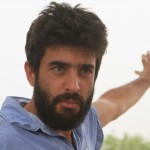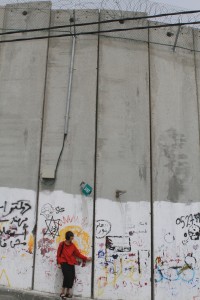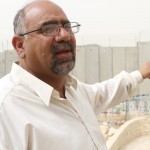Guest blog by Gerri Haynes: Delegates meet with Israeli activist
As she did last year, Gerri has organized a Washington Physicians for Social Responsibility delegation of doctors and other health care providers to work in hospitals and clinics in Gaza in an effort to directly help the people there and to bring attention to the ongoing humanitarian crisis that the Israeli blockade has created. She has been sending back reports from inside and outside the Israeli blockade.
Today felt like a bonus day. We waited for a meeting that didn’t happen, then were treated to an exquisite history and tour of East Jerusalem by Yohav, a member of the Israeli Committee Against Housing Demolitions. With brilliance and humor, Yohav dismantled Israel’s approach to occupation and settlement development.

Yohav of the Israeli Committee Against Housing Demolitions. (Bob Haynes photo)
He claimed that the decrease in suicide bombings is not due to the Wall, but more probably due to a very effective Israeli secret police force and a decision by Palestinians that suicide bombing was not being effective. Since 20,000 Palestinians move “illegally” into Israel every day to work (without a permit and by moving around the Wall), he held that it is illogical to believe that the Wall is the major cause for a decrease in suicide bombings.

The Israeli built wall along the border. (Bob Haynes photo)
Building permits are rarely awarded to Palestinians in East Jerusalem and residents who build without a permit are fined and/or their home is destroyed. Since 1967, more than 25,000 Palestinian homes have been destroyed. New, permitted, construction is underway in East Jerusalem – for Jewish Israelis. We drove through Sheikh Jarrah – an area under present contention.

Peacemaker Zoughbi Zoughbi. (Bob Haynes photo)
Zoughbi is a member of the City Council of Bethlehem and very active in conflict resolution for the people of his city. As we walked with him to the Nativity Church, almost every person we passed greeted him by name.
In the Wi’am office, we met Amira – a delightful woman who is studying and writing about the Nakba. She related her tunnel experience in 2006. Unable to gain admission to Gaza, she walked and crawled through one of the tunnels – spent two weeks learning about the situation of that politically tumultuous time – then walked and crawled through a tunnel back to Egypt.
Having just seen the tunnel area in Rafah, we were stunned by the thought of this petite and courageous woman finding her way in and out of Gaza through this most dangerous route.
Reluctantly, we said goodbye to Zoughbi – our friend since the first WPSR visit to this area of the world in 1993. He has traveled with WPSR delegations to Iraq and Syria and throughout his home.
We wish for Zoughbi and all the people of this region a pathway to peace.
RSS feed for comments on this post. TrackBack URI